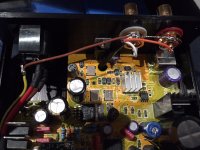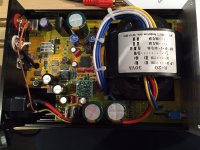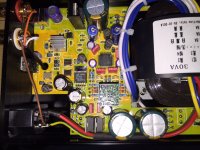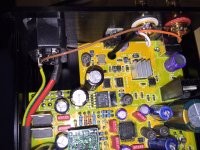its the regulators, their interpretation that makes it an Exclusive OR
the expectation with a 3 pin IEC socket is that any exposed metal is connected to the PE pin, anyone putting together a system, evaluating the system electrical safety, will rely on that expectation
you can still have isolated floating signal level circuitry on the secondary side - but it really should be shipped with the signal connectors shrouded in insulating caps with manuals/installation instructions spelling out the secondary isolation characteristics
the expectation with a 3 pin IEC socket is that any exposed metal is connected to the PE pin, anyone putting together a system, evaluating the system electrical safety, will rely on that expectation
you can still have isolated floating signal level circuitry on the secondary side - but it really should be shipped with the signal connectors shrouded in insulating caps with manuals/installation instructions spelling out the secondary isolation characteristics
No.By definition, R-Core transformer is a double insulated device.....................
If you purchase equipment from china and import it yourself, which increasingly is what is happening, are you not responsible that the equipment is compliant with the local regulations?
ClassI is quite different to ClassII.
ClassI requires the protection afforded by the external envelope/Chassis to be permanently connected to PE.
ClassII requires the insulation to be at two levels and for a hazard fault, both levels of insulation need to fail. Additionally there must not be a connection to allow a ClassI type cable to be connected that would invalidate the NO PE connection. i.e. there must not be a PE pin in the IEC socket, or it must be impossible to insert a PE equipped plug into the no PE socket.
This last rule also applies in reverse.
A no PE plug must not fit into a ClassI IEC socket. The no PE plug has a blank for the third pin location so that it CANNOT slide into a 3pin socket.
ClassII equipment must be labeled to identify them and must not have their earthing altered by any user/bodger.
ClassI requires the protection afforded by the external envelope/Chassis to be permanently connected to PE.
ClassII requires the insulation to be at two levels and for a hazard fault, both levels of insulation need to fail. Additionally there must not be a connection to allow a ClassI type cable to be connected that would invalidate the NO PE connection. i.e. there must not be a PE pin in the IEC socket, or it must be impossible to insert a PE equipped plug into the no PE socket.
This last rule also applies in reverse.
A no PE plug must not fit into a ClassI IEC socket. The no PE plug has a blank for the third pin location so that it CANNOT slide into a 3pin socket.
ClassII equipment must be labeled to identify them and must not have their earthing altered by any user/bodger.
good question.If you purchase equipment from china and import it yourself, which increasingly is what is happening, are you not responsible that the equipment is compliant with the local regulations?
One to ask your house and contents insurer after your house burns down, or your child is in hospital after the device exploded.
that's a good question... however, you a priory assume that the equipment manufactured in China does not comply with the local (Chinese) safety regulations...no? Or, I can rephrase that to say: if it complies with Chinese regulations, it will comply with EU safety regulations as well... hence no need to worry... yes/no?
Nick
Nick
good question.
One to ask your house and contents insurer after your house burns down, or your child is in hospital after the device exploded.
it is just a DAC....
Nick
My experience of chinese electronics is that unless its a big branded item it will not comply with ANY regulations. Often compliance marks are put on with no idea of what the detail of the regulations are.
It may be just a DAC but it only takes a small fire to burn a house down.
OK, we are being pessimistic here, but people need to be aware.
It may be just a DAC but it only takes a small fire to burn a house down.
OK, we are being pessimistic here, but people need to be aware.
Probably not if it's fallen out of the skip by the back door.that's a good question... however, you a priory assume that the equipment manufactured in China does not comply with the local (Chinese) safety regulations...no? Or, I can rephrase that to say: if it complies with Chinese regulations, it will comply with EU safety regulations as well... hence no need to worry... yes/no?.........
A faulty DAC, or etc ..., can kill you just as easily as any other bit of faulty equipment.it is just a DAC.......
I do wonder if the really cheap stuff is from the "Failed QA" bin at the back door, that unscrupulous workers/vendors/resellers/fraudsters want to make a quick buck from.
And this would apply whatever the country of origin.
I recently picked up a small usb DAC on fleabay and noticed that the earth pin on IEC socket doesn't connect to the chassis, instead it is wired to the ground of the r-core transformer.
I tested with a continuity meter and there's no connection between the earth pin and the chassis at all. Isn't this rather unsafe? Or is it ok given the transformer is in fact grounded to the IEC socket?
On another note, the ground shield of the RCA output sockets were also not grounded to the mains earth. There was some slight humming, but this disappeared when I soldered some hookup wire from the shield/ground of the RCA sockets to the earth pin on the IEC socket - I assume it is safe to leave it like this now, or should I have grounded the signal ground to the mains ground via a resistor, capacitor or some diodes?
I just remembered that we hand all our equipment to a licences electrician for the "safety tagging" every six months. You could probably do the same, if you are concerned about the local compliance and/or safety in general. The electrician will test the mains cable AND the DAC, and will place a tag that says the equipment is safe to use. The tag will have his name / name of the company written on it, so liability is firmly established as well.
Nick
No. To take a common problem, you can't accidentally manufacture items with all the EMC suppression capacitors missing but all the EMC suppression inductors replaced by wire links. This has to be deliberate. You can't accidentally manufacture items where mains and the user are separated by just a transistor heatsink insulator.AndrewT said:I do wonder if the really cheap stuff is from the "Failed QA" bin at the back door, that unscrupulous workers/vendors/resellers/fraudsters want to make a quick buck from.
Do they have safety regulations? Even if they do, satisfying them would not guarantee satisfying EU or North American regs.Extreme_Boky said:that's a good question... however, you a priory assume that the equipment manufactured in China does not comply with the local (Chinese) safety regulations...no? Or, I can rephrase that to say: if it complies with Chinese regulations, it will comply with EU safety regulations as well... hence no need to worry... yes/no?
Recently there was a case in England. An importer was fined for dangerous Chinese goods. He actually told the court that he thought that "CE" meant "China Export", thus leaving the court to decide whether he was very ignorant or very dishonest.
Can the OP take a picture of his unit? So far I have not seen any.
I have checked IEC 61140, which specifically deals with this issue. The arrangement (just grounding the core and perhaps a static shield of the transformer) while the rest of the device is constructed as a class II device is not prohibited. The transformer's core must be insulated with "basic insulation" (so double insulation is not required) from other live parts and accessible parts, and the device shall not be marked with the double insulation symbol. Only when there is a recognized functional requirement for the protective earth to be connected, an earth connection may be present on a device marked as double insulated. I don't think an audio DAC is recognized for this by the IEC though, I haven't checked.
So the arrangement as described is allowed when:
I have checked IEC 61140, which specifically deals with this issue. The arrangement (just grounding the core and perhaps a static shield of the transformer) while the rest of the device is constructed as a class II device is not prohibited. The transformer's core must be insulated with "basic insulation" (so double insulation is not required) from other live parts and accessible parts, and the device shall not be marked with the double insulation symbol. Only when there is a recognized functional requirement for the protective earth to be connected, an earth connection may be present on a device marked as double insulated. I don't think an audio DAC is recognized for this by the IEC though, I haven't checked.
So the arrangement as described is allowed when:
- the grounded parts are insulated from their environment by basic insulation AND
- the rest of the device is constructed with double insulation AND
- the device is not marked as double insulated AND
- grounding is marked as required
Last edited:
Can the OP take a picture of his unit?
Here's a few pics, as you can see the earth pin is soldered to the R-CORE ground. The link between the earth pin & the output signal ground (brown wire) was installed by me.
Attachments
It looks like the transformer ground connection is a static screen. Connecting it this way is allowed, but the ground connection you added is not, because it brings the internal insulated ground circuit out to a place where you can touch it. They even tried to double insulate the mains wiring with heatshrink, although the sleeve is a bit short IMHO. The mains wiring can still rub against the +/- 15V regulators.
I see that they have tried to connect the case to signal ground through the back of the 7805 regulator (next to the RCA sockets), did you check if it makes proper contact? If not, then the case floats with respect to the circuit and could cause the reported hum issue.
I see that they have tried to connect the case to signal ground through the back of the 7805 regulator (next to the RCA sockets), did you check if it makes proper contact? If not, then the case floats with respect to the circuit and could cause the reported hum issue.
.............................
I have checked IEC 61140, which specifically deals with this issue. The arrangement (just grounding the core and perhaps a static shield of the transformer) while the rest of the device is constructed as a class II device is not prohibited. The transformer's core must be insulated with "basic insulation" (so double insulation is not required) from other live parts and accessible parts, and the device shall not be marked with the double insulation symbol. Only when there is a recognized functional requirement for the protective earth to be connected, an earth connection may be present on a device marked as double insulated. I don't think an audio DAC is recognized for this by the IEC though, I haven't checked.
So the arrangement as described is allowed when:
In this way, you have a mostly-class-II device, with some parts (the transformer) being only class I. As long as these class I parts are properly grounded and insulated as required, it is fine. So if your transformer has a static screen and an earthed core, and these parts are the only parts connected to earth, the situation is OK, provided the earthed parts are insulated from the rest of the device (which they seem to be by the description), and the device is marked as a class I (earth required) appliance.
- the grounded parts are insulated from their environment by basic insulation AND
- the rest of the device is constructed with double insulation AND
- the device is not marked as double insulated AND
- grounding is marked as required
I don't think your interpretation allows for a mains wire coming loose, or breaking away from it's terminal and springing out to touch the chassis.
What would happen in this case?
Would the mains fuse blow? Would the case become live?
Last edited:
In case of a mains wire coming loose, the case becomes live, that's why there should always be double or reinforced insulation between conductors and any metal part that can be touched, in case you don't want to ground those parts. And, needless to say, the internal mains wiring should be well supported.
I don't know where you're going. Are you preparing to say that double insulated gear may not be enclosed in a metal enclosure?
In case of the above pictured DAC, I see a couple of problem areas, but a wire coming loose is not on top of my list. The mains wiring coming very close to the voltage regulators looks shabby to me. If a failure occurs, and the regulator overheats, the tab can melt its way through the wire's insulation and make contact with the conductors. The wire should be kept away from such components by proper routing and support. Also, I find the heat shrink sleeve too short. Note that putting on extra heatshrink does not solve the previous point.
I don't know where you're going. Are you preparing to say that double insulated gear may not be enclosed in a metal enclosure?
In case of the above pictured DAC, I see a couple of problem areas, but a wire coming loose is not on top of my list. The mains wiring coming very close to the voltage regulators looks shabby to me. If a failure occurs, and the regulator overheats, the tab can melt its way through the wire's insulation and make contact with the conductors. The wire should be kept away from such components by proper routing and support. Also, I find the heat shrink sleeve too short. Note that putting on extra heatshrink does not solve the previous point.
Last edited:
No, it's just that the conditions you explained as necessary did not seem to protect from a flailing wire.
My post # 32 only addresses a permissible way of grounding internal components of a device. Wire routing and support is a different (and equally important) topic, but since the original question was not "is the wire routing OK?", I initially didn't address it. And before the pictures came, there was no way to provide any appropriate comments.
Last edited:
- Status
- Not open for further replies.
- Home
- Source & Line
- Digital Source
- mains earth -> signal grounding




